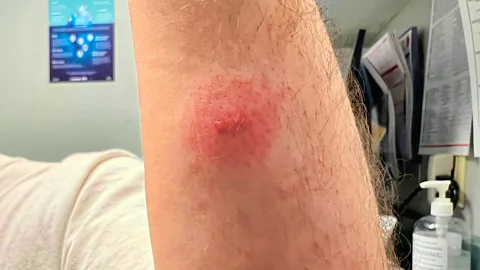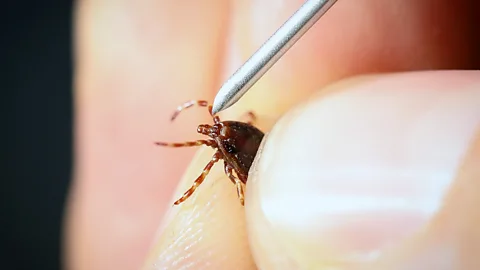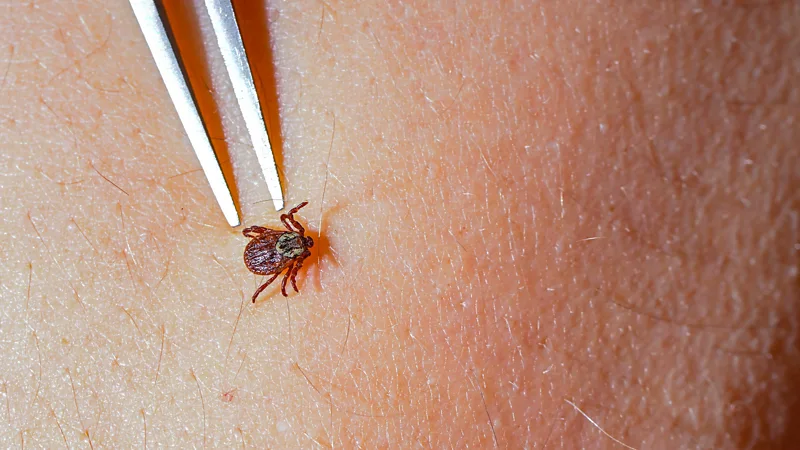Climate change is contributing to the global rise of Lyme disease. But many physicians are struggling to recognise its symptoms.
Ticks are blood sucking parasites and second only to mosquitos when it comes to transmitting diseases to humans. But when that bite happens, along with the potential risk of infection and serious illness, you may not even feel it.
These spider-like arachnids, with eight legs and a body no bigger than an apple seed, can secrete an anti-inflammatory substance to disguise its feeding. This allows a host of disease-causing pathogens that may have infected the tick beforehand to freeload a ride into your bloodstream.
The most well-known of these freeloaders is the spiral-shaped bacteria Borrelia burgdorferi which causes Borreliosis or Lyme disease. It is named after the town of Lyme in Connecticut in the United States, where it was first identified in 1975 after both children and adults began reporting symptoms similar to arthritis.
Lyme, however, is a disease with many more symptoms, and these can get more varied if treatment is not prompt. “It’s a type of bacteria that penetrates every tissue in the body,” says Jack Lambert, a consultant in infectious diseases, professor of medicine at University College Dublin and founder of the Lyme Resource Centre.
 A bite from an infected tick often creates a characteristic “bullseye” rash, but symptoms can vary widely (Credit: Getty Images)
A bite from an infected tick often creates a characteristic “bullseye” rash, but symptoms can vary widely (Credit: Getty Images)“It goes to the brain, it goes to the joints. It goes to the muscles, the nervous system, the peripheral nervous system, the bladder and the gut,” Lambert says.
Lyme disease can also cause facial paralysis, heart problems, severe fatigue and painful pins and needles in hands and feet. As a result, the range of symptoms means not every patient is taken seriously.
“Early in the days of Lyme disease there was a big debate,” says Brian Fallon, director of the Lyme and Tick-Borne Diseases Research Center at Columbia University in New York. “Are patients making it up? Are they hypochondriacs where they think they’re ill when they’re not? That’s what led to a lot of struggles in the early 1990s with how to treat these patients.”
That struggle continues. The Welsh rapper Ren, for example, was initially diagnosed with bipolar disease and chronic fatigue syndrome. Bedbound for several years, he even had to suspend his music career before being accurately diagnosed with Lyme in 2015; he still receives treatment for autoimmune conditions as a result of the infection.
“The bullseye rash is not always a bullseye,” says Lambert. “It can be elliptical. It could be a solid rash. It can be a blistering rash. It can be a bruise. Also, on dark skin, it doesn’t look like a bullseye at all. Even when you have a classic bullseye rash, the GP often diagnoses it as ringworm. But ringworm is only a rash. It doesn’t have joint pain or memory problems.”
At this point, I will admit to having (literal) skin in the game after being bitten by a tick in June 2023, most likely while on a wildflower walk. Ticks are found on mammals such as cattle, deer, mice and pets, but in between feeding they also perch at the end of low-lying grasses and vegetation waiting for unsuspecting victims.
Over the next three months, three different medical professionals dismissed my expanding rash because it was not a bullseye. I was prescribed anti-fungal, then anti-bacterial and anti-histamine creams. The rash simply got bigger.
I was eventually diagnosed with Lyme in the US, in September 2023, while visiting my son in Pennsylvania. By this time the rash had expanded from 2-3 cm (0.8 to 1.2in) to a red, rugby ball-shaped blotch covering my entire stomach. A similar rash was also encircling my left knee.
Fortunately (for me, if not for the locals), Pennsylvania is a hotspot for the disease. In the US alone, around 476,000 people are diagnosed with Lyme disease each year, mostly from the black legged “deer” tick. Many hikers carry tweezers specifically to pull out any ticks found embedded, face first, on their skin.
After diagnosing me, the physician prescribed a month-long course of the antibiotic doxycycline. The rashes on my stomach and knee faded and disappeared. A general uneasy malaise of feeling “something’s not right”, along with the headaches, tiredness, night sweats and difficulty sleeping, also reduced. Knowing Lyme disease had the potential to cause serious long term health issues, it was a huge relief.
Recently, singers Justin Bieber, Shania Twain and Avril Lavigne, actor Ben Stiller, model Bella Hadid, comedian Amy Schumer and 22-year-old Belgian cyclist Arnaud De Lie have all gone public about contracting Lyme.
“A sub-group of patients can develop a significantly impairing illness,” says Fallon. “That’s been one of the conundrums and puzzles in the Lyme disease world, which is why do most people get well while others go onto develop persistent symptoms.”
Unfortunately, within weeks of ending treatment, my symptoms both returned and expanded. By January 2024 I was struggling with some memory loss and mentally grappling for certain words, as well as a stiff neck and extraordinary fatigue. The standard diagnosis uses two Lyme tests, the enzyme-linked immunosorbent assay (Elisa) and a test called western blot. These detect antibodies in the blood specific to the Borrelia bacteria but not a live infection. In my case, they did show reactivated Epstein-Barr virus, which often accompanies auto-immune diseases, and several other tick-related bacterial co-infections: Babesiosis, Ehrlichiosis and Bartonellosis.
One year after my initial tick bite, I have taken three month-long courses of antibiotics and am now one of those deemed to have post-treatment Lyme disease syndrome. The tiredness has alleviated, but I am still dealing with neuropathy in the form of an unpleasant persistent tingling in my feet and legs. I also can’t shake the fear that my swollen left knee is Lyme-related arthritis and not the long-lasting result of a tennis injury.
Nevertheless, I consider myself lucky. Richard Wilson, a documentary filmmaker and former BBC environment correspondent, was bitten by a tick in 2016. Despite finding the tick embedded in his arm and developing a rash within days, he was informed: “It isn’t a bullseye so it’s not Lyme.”
Two years later, after persistent issues with tiredness and gut issues, he insisted on a Lyme test. It came back negative. “What nobody told me is that tests can be as much as 25% false negative,” he tells me.
Lambert likened it to how people can get negative Covid tests yet still have symptoms of the disease. “We use common sense when it comes to Long Covid,” he says. “Their immune system has been lowered by years of fighting this infection. When it comes to Lyme disease, we seem to be lacking education at all levels in medical practice. Gaslighting is a major issue.”
For the next few years Wilson’s symptoms were assigned to numerous conditions. All were progressively ruled out. “I think I’ve had seven gallstone referrals now,” he said. “So out came my gallbladder and out went the contents of my bank balance and nothing changed.”
Wilson’s Lyme remained untreated until a test finally came back positive, almost eight years after the initial tick bite. Many seek out specialist Lyme clinics at personal expense. “If I had at that point been given antibiotics,” he says, “I think things would have turned out very differently.”
The treatment of chronic Lyme disease – when symptoms continue six months after treatment or longer – attracts controversy, especially the use of herbal remedies. While some are receiving medical interest, few have been peer reviewed in scientific journals. I am currently on a herbal cocktail which includes wormwood, reishi mushroom extract, resveratrol, Chinese skullcap, oil of oregano and cat’s claw bark. Several of these show promise in vitro but fall into the “more evidence needed” category. But how many courses of antibiotics are enough?
“Patients have turned to herbalists because that was the only option,” says Lambert. “Some have anti-infective capacities and they do work but have they been tested? No, because there’s no incentive to do studies. Some people get non-traditional treatment, such as hypothermia to kill off bacteria. I disagree. There are some questionable therapies out there. The best way to treat an infection is antibiotics.”
There used to be a vaccine, LYMERix, but this was discontinued in 2002 by SmithKlein Beecham (now GlaxoSmithKlein) due to a combination of declining sales and negative media coverage at a time of public lack of confidence in vaccines and the risk of potential side effects. “It’s outrageous that we don’t have a vaccine,” says Fallon. “We do have one vaccine [by Pfizer] that is in phase three trials right now that will hopefully come on the market in the next few years.
“The good news is that most people can get better over time,” he says. “It’s the post-infectious Lyme arthritis which is challenging and those unfortunate people who do have persistent severe issues. We are at a time in history where medicine is advancing rapidly, there’s going to be tremendous advances in the next five to 10 years.”
If you are looking to order local products, handcraft, custom clothes, various books, handmade arts, furniture’s, food spices etc. please, visit our web page at www.ethio-amazon.com. Or send us your request at email contact@ethio-amazon.com you can also contact us on WhatsApp at +2519-44-36-97-53
Additionally, if you would be interested to socialize and looking for a new friend around the world, for future partnership… visit our web page at www.contactyourlifepartner.com
We believed that love can happen anytime, anywhere in a world filled with endless possibilities… for more information contact us at Email contact@ethio-amazon.com or Call us at +2519-44-36-97-53 (WhatsApp) , + 6676539901 (international)
Source ( BBC News )


